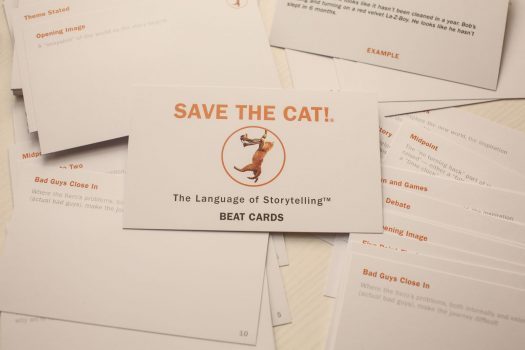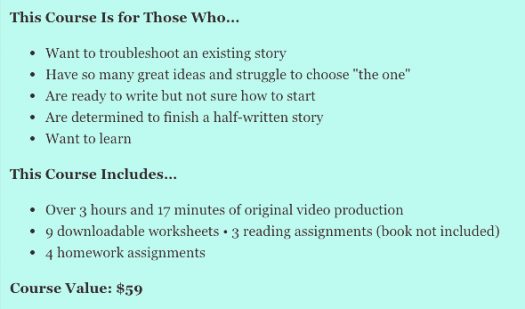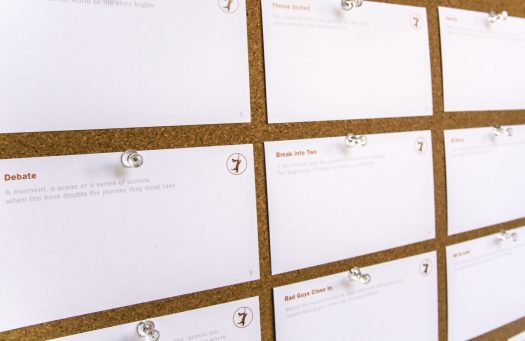Save the Cat! A Review: Online Course and Story Cards
By Therese Walsh | March 13, 2021 |

Earlier today, I reposted a vintage interview with the late Blake Snyder and I hope you’ve had the chance to take a look at it. Blake was a storytelling guru who captured many a groundbreaking thought in his book Save the Cat! That book has gone on to become a valuable tool within the film industry, and has recently been adapted for use by novelists thanks to author Jessica Brody (Save the Cat! Writes a Novel). I’m a devotee of Save the Cat! and Blake Snyder, and so it was a no-brainer for me to accept when asked to review a new cat-centric online course and two sets of story cards. Without further amew…
Save the Cat! The Course

I watched most of this online course over three days, but it’s designed to be consumed at whatever pace feels best for you. The course–a blend of video segments presented by filmmaker Jennifer Zhang, downloadable worksheets, and homework assignments– is different from the book in that it concentrates two ideas foundational to Blake’s teachings: genres and story beats.
Genres. Nearly every story, Blake says, falls into one of 10 story genres. These genres are neither what you may be familiar with nor are they what you may guess they are at a glance: Monster in the House, Golden Fleece, Out of the Bottle, Dude with a Problem, Rites of Passage, Buddy Love, Whydunit, Fool Triumphant, Institutionalized and Superhero. (A Beautiful Mind is a Superhero film. Surprise!) Knowing the genre of your story allows you to identify stories built like your own and study how certain beats were approached, excavated, and resolved for best effect in a variety of films. This is of course different than reading in a chosen field and studying those books in order to write a better fantasy, romance, women’s fiction novel, mystery, psychological suspense, horror, etc. And it can be illuminating to step away from “the box” of traditional genre labels to absorb other ideas. Blake’s dissection of story into unique groupings is conceptually brilliant and can make for–at the very least–an empowering exercise when applied to your own work.
Beats. While Blake didn’t invent the idea of story beats, he evolved it after seeing the lack of a reliable guide to the connective tissue needed between act breaks. Using the same analytical skills used to recognize the DNA of story types, he identified 15 critical story beats, then went about explaining, testing, and proving them through a plethora of examples. (The Save the Cat blog continues to introduce new films to explore and prove the strength of the approach.)
I enjoyed the class and the chance to dust off my memory of Blake’s concepts and apply them to my current projects. I thought the worksheets were useful, and printed a few of them out for future reference. I can see, too, how people who’ve never been exposed to Blake’s ideas might benefit from this CliffsNotes-like course or use it as a complement to the Save the Cat! book. Personally, I wouldn’t use the course as a replacement for the book–there is deep gold in Save the Cat! and you’ll develop a more fulsome sense of Blake’s ideas and Blake himself through the pages–but the course is (a) a good guided introduction of core elements, (b) can be a good tool for re-immersion if you’re familiar with Blake’s ideas but it’s been a minute, and (c) will likely get your wheels turning on a work-in-progress and thinking about that story in a new and likely productive way regardless.

Save the Cat! The Cards

The Save the Cat! Story cards are separate purchases. You might see value in one or both of these.
Beat Cards. One pack of beat cards comes with 3 sets of 15 cards, numbered with Blake’s beats and a brief summary/reminder of what those beats mean in the world of your story. Could you achieve the same end by filling out a beat sheet? You could. But if you’re a cork board writer, you might appreciate having the guide before you in this manner and being forced to capture everything in short form.
Scene Cards. One pack of scene cards comes as a pack of 50 cards, edged in one of four colors–orange, blue, yellow, and gray. Each of the cards prompts you for critical information over a scene: location, notable moment/action, emotional change, and to “name the conflict, the good guy and obstacle.” On the one hand, this is basic stuff. On the other hand, it’s the stuff storytellers often forget to attend to and then because of that–oops!–they’ve dragged their characters into a corner or lost the thread of the story. Forcing yourself to justify every scene with these details could prove helpful in keeping your story on track; they may genuinely save a writer time. The colored cards would also make it easy to control the pacing of secondary storylines.

You can learn more about all things CAT! by following these links:
Save the Cat! Cracking the Beat Sheet Online Course: savethecatcourses.com/courses/cracking-the-beat-sheet
Save the Cat! Story Cards: savethecat.com/story-cards
Save the Cat! Best-Selling Books: savethecat.com/books
Don’t forget to check out my classic interview with Blake Snyder, right here. Write on.










Thank you for all that Theresa. I’m just getting started on the fiction thing and need all the help I can get.
gramswisewords.blogspot.com
Good luck to you, Maz!
This is awesome! Thank you for posting.
Thanks for reading!
Interesting. I’d wondered about the course, and then bought Save The Cat Writes A Novel, which I have started but not finished yet. I thought the free preview with the different films was interesting, although I hadn[t seen them all.